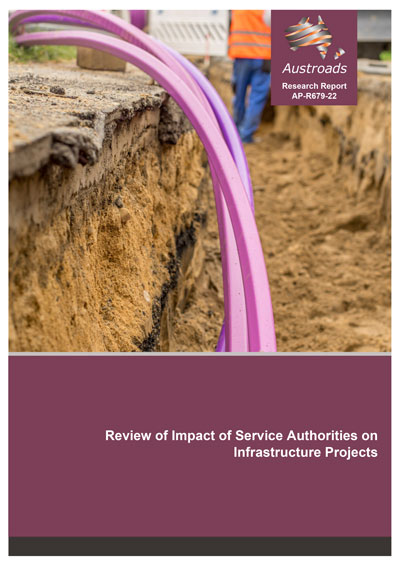Project Delivery

- Publication no: AP-R679-22
- ISBN: 978-1-922700-56-8
- Published: 30 November 2022
- PDF (free) Download
Third party assets on road and rail projects have a significant impact on major projects. This report documents a project to reduce the negative impacts of third-party assets on the successful delivery of road infrastructure projects across Australia.
The project methodology included a literature review, extensive consultation with selected jurisdictions through a Project Working Group, wider consultation through interviews and surveys, and research into five case studies.
The project identified 15 high-level issue groups and explored these in detail. The analysis confirmed the complexity and interrelationships of these, highlighting the many ways in which protecting or relocating utility assets affect costs and project timings. The diversity of type, scale and impact of utility assets means that there are no unitary or single solutions.
The research produced practical, experience-based solutions that can be applied across suitable projects and a framework for future cost assessment which will support measurement, comparison and the development of better practice across all jurisdictions over the long run.
Watch a webinar with Robert Eames, Nicola Boyd, David Bourne and Maria Drysdale to hear about the research findings in detail.
- Summary
- Definitions and Terms
- 1. Introduction
- 1.1 Purpose
- 1.2 Scope
- 1.3 Overview of the Problem
- 2. Literature Review
- 2.1 Scope
- 2.2 Methodology
- 2.2.1 Web Search
- 2.2.2 Jurisdictional Survey
- 2.3 High Level Findings
- 2.4 International Experience
- 2.4.1 United States of America
- 2.4.2 Canada
- 2.4.3 United Kingdom
- 2.4.4 Collaborative
- 2.5 Relevant Resources
- 2.5.1 Managing the Transport Agency – Utility Interface
- 2.5.2 Project Design
- 2.5.3 Project Delivery
- 2.5.4 Better Practice, Practical and Instructional
- 2.5.5 Technical
- 2.5.6 Data and Reporting
- 2.5.7 Analytical
- 2.6 Issues and Risks
- 2.7 Solutions and Better Practices
- 2.8 Conclusions
- 3. Current Practice – Australia and New Zealand
- 3.1 Overview
- 3.1.1 Regulatory Framework
- 3.2 Issues and Barriers to Change
- 3.2.1 Introduction
- 3.2.2 Information Gathering Methodology
- 3.2.3 Categorising Issues
- 3.2.4 Barriers to Change
- 3.2.5 Description of Each Issue
- 3.1 Overview
- 4. Case Studies
- 4.1 Choice of Case Studies
- 4.2 Case Study Development Process
- 4.3 Case Study 1 – Parramatta Light Rail (Stage 1), New South Wales
- 4.3.1 Description
- 4.3.2 Utility Summary
- 4.3.3 Observations
- 4.4 Case Study 2 – Plenty Road Upgrade Stage 2, Victoria
- 4.4.1 Description
- 4.4.2 Utility Summary
- 4.4.3 Observations
- 4.5 Case Study 3 – Denny Avenue Level Crossing Removal, Western Australia
- 4.5.1 Description
- 4.5.2 Utility Summary
- 4.5.3 Observations
- 4.6 Case Study 4 – Elwick, Goodwood and Howard Roads Junctions Upgrade, Tasmania
- 4.6.1 Description
- 4.6.2 Utility Summary
- 4.6.3 Observations
- 5. Solutions
- 5.1 Objective
- 5.2 Solutions Development Methodology
- 5.3 The Nature of a Solution
- 5.4 Solution Elements
- 5.4.1 Legislative and Regulatory Framework
- 5.4.2 Formal Structures
- 5.4.3 Informal Relationships
- 5.4.4 Mutual Understanding
- 5.4.5 Financial and Cost Approaches
- 5.4.6 Project Planning
- 5.4.7 Project Management
- 5.4.8 Digital and Data
- 5.4.9 Contracts and Commercial Arrangements
- 5.4.10 Strategic Design
- 6. Costing Dataset Framework
- 6.1 Measurement Objectives
- 6.2 Context
- 6.3 Logical Model
- 6.4 Data Elements
- 7. Conclusions
- 7.1 Introduction
- 7.2 Conclusion 1 – Complexity is at the Core of the Problem
- 7.3 Conclusion 2 – The Problem Is Shared
- 7.4 Conclusion 3 – The Way the Problem is Structured Constrains Solutions
- 7.5 Conclusion 4 – Better Information is Fundamental for Better Outcomes
- 7.6 Conclusion 5 – There is a Real Opportunity to Move Utility Asset Management From ‘Zero Sum’ to
- ‘Net Gain’
- 7.7 Conclusion 6 – The Cost Dimension is Amplified by a Time Dimension
- 7.8 Conclusion 7 – Different Experiences Create Opportunities for Optimisation
- References
- Appendix A Literature Review Checklist
- Appendix B Issues Ranking
- Appendix C Dataset Example
- Appendix D Literature Review Summary
